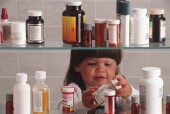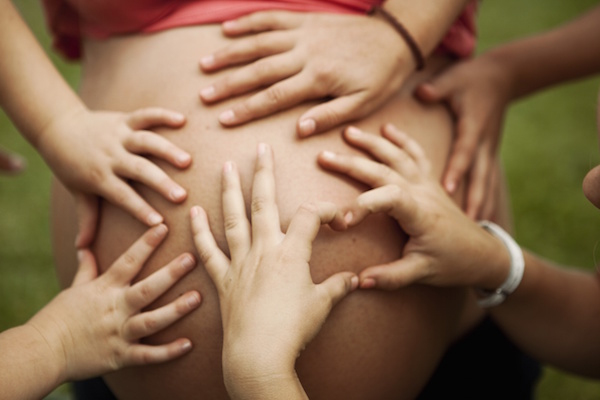
FRIDAY, Sept. 17 (HealthDay News) — Most parents these days are mindful of obvious poisoning risks to their children. They lock up household cleaners and keep chemicals and pesticides well out of the reach of youngsters.
But health experts believe the most prevalent poisoning threat in a person’s household isn’t under the sink or in the garage — but in the medicine cabinet.
Two of every three pediatric poisonings that result in an emergency room visit are caused by medication overdoses, according to the U.S. Centers for Disease Control and Prevention.
In fact, the rate of childhood poisonings caused by medication overdoses is double the rate of poisonings from cleaning substances, pesticides, personal care products and other toxic household substances, the CDC reports.
Medications tend to be more accessible to children than other toxic substances in the home, poison control experts said. And, parents tend to place too much faith in child-resistant caps and other safeguards.
“Normally what occurs when someone is taking medicine on a chronic basis, they’ll leave it out,” said Jay L. Schauben, a pharmacist and director of the Florida Poison Information Center in Jacksonville, Fla. “Any pills left out are within the grasp and reach of a child. Some of the medicine can look like candy. Some of the cough syrups are flavored and taste good. You can sort of see how that would be a disaster waiting to happen.”
The medications children overdose on most often are the over-the-counter drugs ubiquitous to American households, said Edward Krenzelok, a pharmacist and director of the Pittsburgh Poison Center at the University of Pittsburgh Medical Center.
Nearly 10 percent of all poisonings in children 5 years old or younger involve common analgesics, according to the annual data report of the American Association of Poison Control Centers.
“The most common medication anyone’s going to have around the home is a non-prescription pain reliever,” Krenzelok said.
Ointments and creams, cough and cold remedies, vitamins, antihistamines and products for gastrointestinal distress cause another 21.5 percent of pediatric poisonings.
Part of the problem, the experts agree, is that people tend to not treat over-the-counter medications as something that could cause harm in young children. “They figure if they didn’t need a prescription or got it from a pharmacist, it must be safe,” Schauben said. “They are more apt to leave it out or have a lot more leeway leaving it on the counter.”
This can lead to a child overdosing because, for instance, the child comes across medication and figures it’s a treat.
“A 3-year-old may see two really pretty tablets on a counter and think they are candy, like M&Ms or Skittles,” Krenzelok said.
Younger children also can be inadvertently poisoned by medications within their reach simply because little kids tend to put things in their mouths.
“They’re sampling their environment,” Krenzelok said. “They have a lot of hand-to-mouth activity. They constantly put things in their mouths. If you put a pen down and a 16-month-old wanders over, what are they going to do? They’re going to put the pen in their mouth.”
To protect children, all medications — prescription and over-the-counter — should be kept in a locked cabinet, out of the reach of kids, Schauben said. Avoid keeping any medications on counters or nightstands, even if the drugs are in child-resistant containers.
“I will tell you very emphatically right now there is no such thing as a childproof container,” Schauben said. “These containers are child-resistant. When they are tested, they are given to children. The bottom line is, can they be kept out of the medication for a certain period of time, not forever. Given enough time, a child will assuredly figure out how to defeat a childproof cap.”
Don’t keep your medications in a traditional medicine cabinet, either. “When the child is old enough, they can climb up and get into the cabinet,” Schauben said. “The medicine cabinet is the absolute worst place to keep your medications anyway. Drugs need to be kept in a cool, dry place.”
Parents also should be alert to potential drug poisonings when there are guests in the house.
“If Aunt Sally comes to visit and brings her medication to your home, is she going to line them up on her cabinet and make them available to your children?” Schauben said. He suggests talking to guests about keeping medications out of kids’ reach, or at least keeping a watchful eye on children during the visit.
A child who does swallow medication isn’t automatically going to die, Krenzelok and Schauben said. Childhood poisoning fatalities are very low, with just 26 deaths from 1.3 million poisonings in children 5 or younger in 2008, Krenzelok said.
The best thing parents can do if they suspect medication poisoning, experts say, is to first call the Poison Help hotline: 800-222-1222. That number will connect them to the Poison Control Center nearest them.
“The only time you want to call 911 first is if the child is unarousable, the child is having difficulty breathing or the child is having convulsions or seizures,” Schauben said.
Doctors, pharmacists and nurses at the Poison Control Center are experienced in triaging the situation and providing solid advice. Often an expensive and time-consuming trip to the hospital can be avoided with some home health care.
“More than 95 percent of the time, a child will be able to stay at home,” Krenzelok said. “I don’t think just because a child got into something, the parents should automatically pack them into the car and take them to the emergency room. We can determine who needs to go to an ER or not.”
More information
The Nemours Foundation has more o n childproofing your home.
Learn more about help that’s available from a Poison Control Center.

